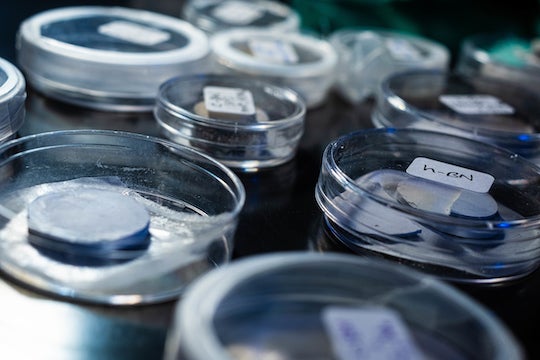Just as carbon makes up both the brittle core of a No. 2 pencil and the harder-than-steel diamond in a cutting tool, boron nitride gives rise to compounds that can be soft or hard. Yet, unlike carbon, far less is known about boron nitride's forms and their responses to changing temperatures and pressures.

Rice University scientists mixed hexagonal boron nitride ⎯ a soft variety also known as "white graphite" ⎯ with cubic boron nitride ⎯ a material second to diamond in hardness ⎯ and found that the resulting nanocomposite interacted with light and heat in unexpected ways that could be useful in next-generation microchips, quantum devices and other advanced technology applications.
"Hexagonal boron nitride is widely used in a variety of products, such as coatings, lubricants and cosmetics," said Abhijit Biswas, a research scientist who is the lead author of a study about the research published in Nano Letters. "It's quite soft and it is a great lubricant, and very lightweight. It's also cheap and very stable at room temperature and under atmospheric pressure.
"Cubic boron nitride is also a very interesting material, with properties that make it very promising for use in electronics. Unlike hexagonal boron nitride, it's super hard ⎯ it's close to diamond in hardness, actually."
The composite of these two seemingly opposite materials outperformed its parent materials in different functionalities.
"We found the composite had low thermal conductivity, which means it could serve as a heat-insulating material in electronic devices, for instance," Biswas said. "The thermal and optical properties of the mixed material are very different from an average of the two boron nitride varieties."

Hanyu Zhu, one of the corresponding authors on the study, said he expected that "the optical property we measure called second harmonic generation would be small for this type of disordered material.
"But it actually turns out to be quite large after heating, an order of magnitude more than both the individual material and the untreated mixture," said Zhu, the William Marsh Rice Chair and assistant professor of materials science and nanoengineering.
He said the boron and nitrogen atoms in the composite displayed greater regularity and formed larger grains, where a grain designates the size of a group of atoms aligned coherently in a lattice.
"We were surprised to find that the cubic boron nitride grains grow instead of diminish in this material from the small grains in the unmixed starting compounds," he said.
Theoretical predictions and experimental results yielded competing claims about which of the two boron nitride varieties was the more stable:

"Some theorists say that, at ambient conditions, cubic boron nitride is more stable," Biswas said. "Experimentally, people have seen that hexagonal boron nitride is very stable. So if you ask someone which boron nitride phase is the most stable, they'll likely say hexagonal boron nitride. What we're seeing experimentally is the opposite of what people are saying theory-wise, and it's still up for debate."
When the composite was subjected to a rapid, high-temperature technique known as spark plasma sintering, it transformed into hexagonal boron nitride. Biswas said this confirmed theoretical predictions and helped paint a fuller picture of "which varieties of boron nitrides appear at what conditions."
Moreover, the hexagonal boron nitride obtained after this treatment was of a higher quality than the one initially used for the mixture.
"What we'll be looking at next is whether the spark plasma sintering technique improves the quality of hexagonal boron nitride all on its own, or whether you need the composite to get that effect," Biswas said.

"What is fascinating about this study is that it opens up possibilities to tailor boron nitride materials with the right amounts of hexagonal and cubic structures, thus enabling a broad range of tailored mechanical, thermal, electrical and optical properties in this material," said Pulickel Ajayan, a corresponding author on the study and chair of Rice's Department of Materials Science and Nanoengineering. Ajayan is the Benjamin M. and Mary Greenwood Anderson Professor of Engineering and a professor of materials science and nanoengineering, chemistry, and chemical and biomolecular engineering.
Zhiting Tian, Eugene A. Leinroth Sesquicentennial Faculty Fellow and an associate professor in Cornell University's Sibley School of Mechanical and Aerospace Engineering, is also a corresponding author.
The research was supported by the Army Research Office (W911NF-19-2-0269), the National Science Foundation (2005096), the Office of Naval Research (N00014-22-1-2357) and the Department of Energy (DE-SC0012311).
- Peer-reviewed paper:
-
"Phase Stability of Hexagonal/Cubic Boron Nitride Nanocomposites" | Nano Letters | DOI: 10.1021/acs.nanolett.3c01537
Authors: Abhijit Biswas, Rui Xu, Joyce Christiansen-Salameh, Eugene Jeong, Gustavo Alvarez, Chenxi Li, Anand Puthirath, Bin Gao, Arushi Garg, Tia Gray, Harikishan Kannan, Xiang Zhang, Jacob Elkins, Tymofii Pieshkov, Robert Vajtai, A. Glen Birdwell, Mahesh Neupane, Bradford Pate, Tony Ivanov, Elias Garratt, Pengcheng Dai, Hanyu Zhu, Zhiting Tian and Pulickel Ajayan
- Image downloads:
-
CAPTION: Abhijit Biswas is a research scientist in the Nanomaterials Laboratory at Rice University. (Photo by Jeff Fitlow/Rice University)
Boron nitride samples (Photo by Jeff Fitlow/Rice University)
CAPTION: Hanyu Zhu (Photo by Jeff Fitlow/Rice University)
CAPTION: Pulickel Ajayan (Photo by Jeff Fitlow/Rice University)






